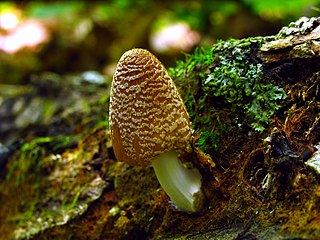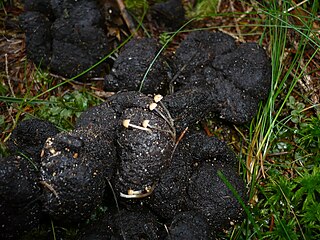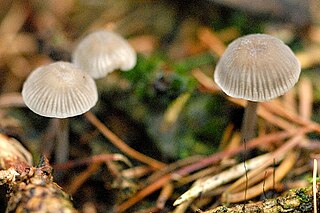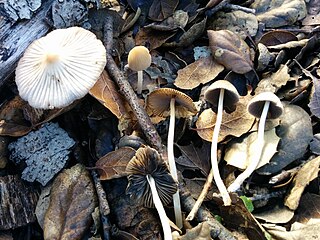
The Psathyrellaceae are a family of dark-spored agarics that generally have rather soft, fragile fruiting bodies, and are characterized by black, dark brown, rarely reddish, or even pastel-colored spore prints. About 50% of species produce fruiting bodies that dissolve into ink-like ooze when the spores are mature via autodigestion. Prior to phylogenetic research based upon DNA comparisons, most of the species that autodigested were classified as Coprinaceae, which contained all of the inky-cap mushrooms. However, the type species of Coprinus, Coprinus comatus, and a few other species, were found to be more closely related to Agaricaceae. The former genus Coprinus was split between two families, and the name "Coprinaceae" became a synonym of Agaricaceae in its 21st-century phylogenetic redefinition. Note that in the 19th and early 20th centuries the family name Agaricaceae had far broader application, while in the late 20th century it had a narrower application. The family name Psathyrellaceae is based on the former Coprinaceae subfamily name Psathyrelloideae. The type genus Psathyrella consists of species that produce fruiting bodies which do not liquify via autodigestion. Psathyrella remained a polyphyletic genus until it was split into several genera including 3 new ones in 2015. Lacrymaria is another genus that does not autodigest its fruiting bodies. It is characterized by rough basidiospores and lamellar edges that exude beads of clear liquid when in prime condition, hence the Latin reference, lacryma (tears).

Coprinellus is a genus of mushroom-forming fungi in the family Psathyrellaceae. The genus was circumscribed by Petter Karsten in 1879. Most Coprinellus species were transferred from the once large genus Coprinus. Molecular studies published in 2001 redistributed Coprinus species to Psathyrella, or the segregate genera Coprinopsis and Coprinellus. As of April 2019, Index Fungorum accepts 66 species of Coprinellus.

Petter Adolf Karsten was a Finnish mycologist, the foremost expert on the fungi of Finland in his day, and known in consequence as the "father of Finnish mycology".

Inocybe hystrix is an agaric fungus in the family Cortinariaceae. It forms mycorrhiza with surrounding deciduous trees. Fruit bodies are usually found growing alone or in small groups on leaf litter during autumn months. Unlike many Inocybe species, Inocybe hystrix is densely covered in brown scales, a characteristic that aids in identification. The mushroom also has a spermatic odour that is especially noticeable when the mushroom is damaged or crushed.
Coprinellus bisporiger is a species of mushroom in the family Psathyrellaceae. It was first described by mycologist P.D. Orton in 1976, and later transferred to the genus Coprinellus in 2001.

Coprinellus domesticus, commonly known as the firerug inkcap, is a species of mushroom in the family Psathyrellaceae. First described as Agaricus domesticus by James Bolton in 1788, it was later known as Coprinus domesticus before it was transferred to the genus Coprinellus in 2001.
Coprinellus congregatus is a species of mushroom in the family Psathyrellaceae. It was first described in 1782 as Agaricus congregatus by French mycologist Jean Baptiste François Pierre Bulliard, and later transferred to the genus Coprinellus in 1879 by Petter Karsten. They are found in North America and Europe.

Coprinellus pellucidus is a species of mushroom in the family Psathyrellaceae. First described as Coprinus pelliculus by the mycologist Petter Karsten in 1882, it was later transferred to the genus Coprinellus in 2001.

Coprinellus micaceus is a common species of fungus in the family Psathyrellaceae with a cosmopolitan distribution. The fruit bodies of the saprobe typically grow in clusters on or near rotting hardwood tree stumps or underground tree roots. Depending on their stage of development, the tawny-brown mushroom caps may range in shape from oval to bell-shaped to convex, and reach diameters up to 30 mm (1.2 in). The caps, marked with fine radial or linear grooves that extend nearly to the center, rest atop whitish stems up to 100 mm (3.9 in) long. In young specimens, the entire cap surface is coated with a fine layer of reflective mica-like cells that provide the inspiration for both the mushroom's species name and the common names mica cap, shiny cap, and glistening inky cap. Although small and with thin flesh, the mushrooms are usually bountiful, as they typically grow in dense clusters. A few hours after collection, the gills will begin to slowly dissolve into a black, inky, spore-laden liquid—an enzymatic process called autodigestion or deliquescence. The fruit bodies are edible before the gills blacken and dissolve, and cooking will stop the autodigestion process.
Coprinellus heptemerus is a species of mushroom in the family Psathyrellaceae. It was first described as Coprinus heptemerus by mycologists M. Lange and Alexander H. Smith in 1952, and later transferred to the genus Coprinellus in 2001.
Coprinellus subimpatiens is a species of mushroom in the family Psathyrellaceae. It was first described as Coprinus subimpatiens by mycologists M. Lange and Alexander H. Smith in 1952, and later transferred to the genus Coprinellus in 2001.
Coprinellus sassii is a species of mushroom in the family Psathyrellaceae. It was first described by mycologists M. Lange and Alexander H. Smith as Coprinus sassii in 1952, and later transferred to the genus Coprinellus in 2001.

Mycena cinerella, commonly known as the mealy bonnet, is an inedible species of mushroom in the family Mycenaceae. It is found in Europe and the United States, where it grows in groups on fallen leaves and needles under pine and Douglas fir. The small grayish mushrooms have caps that are up to 1.5 cm (0.6 in) wide atop stipes that are 5 cm (2.0 in) long and 2.5 mm (0.10 in) thick. Its gills are grayish-white and adnate, with a "tooth" that runs slightly down the stipe. The fungus has both two- and four-spored basidia. As its common name suggests, it smells mealy.

Ripartites is a genus of fungi in the family Tricholomataceae. The genus has a widespread distribution and contains five species. Species in Ripartites have small, round to subglobose spores which are yellowish-brown and ornamented. Macroscopically, they resemble Clitocybe. Ripartites was circumscribed by Petter Karsten in 1879.

Ischnoderma is a genus of polypore fungi. Species in the genus have dark brown and tomentose fruit bodies that become darker brown to black and smooth when mature. The genus, widespread in temperate regions, contains an estimated 10 species.

Bjerkandera is a genus of seven species of wood-rotting fungi in the family Meruliaceae.

Gloiodon is a genus of mushrooms in the family Bondarzewiaceae. It was first described by Finnish mycologist Petter Karsten in 1879.

Coprinellus impatiens is a species of fungus in the family Psathyrellaceae. First described in 1821, it has been classified variously in the genera Psathyrella, Pseudocoprinus, Coprinarius, and Coprinus, before molecular phylogenetics reaffirmed it as a Coprinellus species in 2001. The fungus is found in North America and Europe, where the mushrooms grow on the ground in deciduous forests. The fruit bodies have buff caps that are up to 4 cm (1.6 in) in diameter, held by slender whitish stems that can be up to 10 cm (3.9 in) tall. Several other Coprinopsis species that resemble C. impatiens may be distinguished by differences in appearance, habit, or spore morphology.

Physisporinus vitreus is a species of crust fungus in the family Meripilaceae, and the type species of the genus Physisporinus. It was originally described by Christian Hendrik Persoon by 1796. Petter Adolf Karsten transferred it to the genus Physisporinus in 1889.

Sigfrid Rafael Karsten was a Finnish social anthropologist and philosopher of religion, known especially for his work among the indigenous people of Southern America.














